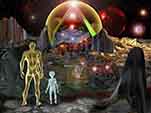By John ReppionFriday, July 18th
Back in March science Writer and blogger Ed Yong gave a TED talk on the subject of parasites and the fascinating ways in which they can sometimes “subvert and override the wills of their hosts”. In his talk Yong spoke about how rodents infected with the brain parasite toxoplasma gondii effectively become “cat-seeking missiles”; seeking out felines and getting themselves eaten just so that toxo can then develop and reproduce inside the cat. As much as one third of the global human population may be infected with toxo. Although mild flu-like symptoms occasionally occur during the first few weeks following exposure, toxo generally produces no symptoms in healthy human adults (toxoplasmosis can be fatal to infants and those with weakened immune systems, however). Opinions are currently divided among researchers as to what, if any, influence toxo has on the behaviour of infected humans (although links to schizophrenia are amongst the effects which have been hypothesised [1]). But, says, Yong in his TED talk, even if it isn’t from toxo, “Given the widespread nature of such manipulations [of hosts by parasites], it would be completely implausible if humans were the only creature not under the same thrall.”
While the idea of mind control via a parasite may seem like science fiction, there is an example we’re all already familiar with: rabies. The rabies virus induces aggressive, violent behaviour in the infected, increasing the chances of the host biting other animals. The rabies virus is transmitted via the saliva of the infected into a new host. It’s a somewhat crude (and oversimplified) example but its one that is pretty much universally accepted and understood.
Not all parasites make themselves so conspicuous however, in fact it may come as a surprise to you that there may be as many as ten times more bacterial cells in your body than there are human cells [2]. 90 trillion or so microbes are your constant passengers; you are a walking ecosystem [3]. The human microbiome (to give it its proper scientific name) is the aggregate of micro-organisms that reside on and inside us; from between our toes, to the tips of our eyelashes, to our gastrointestinal tracts. Some of these organisms perform tasks which are known to be beneficial to us, the host, but the majority have thus far been too poorly researched for us to understand what, if any, role they play in shaping our lives [4]. That however is changing, especially when it comes to the gut–brain axis.
The gut–brain axis refers to the biochemical signalling taking place between the gastrointestinal tract and the nervous system, involving intestinal microbiota (gut bacteria) which have been shown to play an important role in brain function. Changes in gut bacteria are now being investigated as possible contributors to, or triggers for the worsening of, autism [5]. A 2013 study carried out by the University of California found that subjects who regularly ingested beneficial “probiotic” bacteria showed altered brain function [6]. Earlier this year researchers at the University of California, Berkeley, and the University of Arizona, Tucson published that they had found that people living in cold, northern latitudes have bacteria in their guts that may predispose them to obesity [7]. How we process information, how we interact with others and the world around us, even our outward appearance, may all be controlled to some degree by our microbiome. Gut bacteria has even been proven to alter sexual preference (although only in fruit flies thus far) [8]. How much of what we think of as “us”, might actually be “them”?
At the beginning of July 2014 a paper entitled Midichlorians – the biomeme hypothesis: is there a microbial component to religious rituals? was posted on the open access, peer-reviewed online journal Biology Direct (full text here). The paper puts forward the following hypothesis:
Some microorganisms would gain an evolutionary advantage by encouraging human hosts to perform certain rituals that facilitate microbial transmission. We hypothesize that certain aspects of religious behaviour observed in human society could be influenced by microbial host control and that the transmission of some religious rituals could be regarded as a simultaneous transmission of both ideas (memes) and organisms. We call this a “biomeme” hypothesis
Practices such as the touching and kissing of holy relics, drinking from or bathing in sacred waters, and ritual flagellation or piercing of the body are postulated as a possible means of transmission of specific parasites. The practice of fasting, “known to reduce total gut bacteria and affect the gut microbiome composition“, could have a part to play in a parasite’s life cycle, or else its effect upon the host. The veneration, or eschewing, of certain domestic animals could be a means of controlling which parasites the host is exposed to. Even celibacy in holy men and women could be linked to parasitic passengers; “it has been noted that many parasites eliminate their hosts reproductive potential as they channel all available resources to maximize their own reproductive success.”
The hypothesis is completely unproven. It is mere leap of logic or flight of fantasy, depending on your own perception. Responding to one of their learned reviewers (all of whom seem entertained by the hypothesis but highly sceptical), the paper’s authors state “We also agree with Dr. Koonin that our hypothesis is outrageous and may be incorrect, however we believe that it’s still an interesting one and worth considering. […] What makes our hypothesis perceived as more outrageous [than others] is that religion is indeed a taboo subject in human society.”
This response seems to suggest that the idea of parasitic control being a factor in some acts of religious behaviour would be inherently anti-religious; that it would somehow undermine the previously perceived purpose of those acts. But, why should that be the case? If proven to be true, would it not demonstrate that ritualistic religious behaviour had a provable, physical root? If the feelings of community, of belonging, and so on that people get from religious participation were proven to be caused by parasites controlling their hosts (just as the tapeworm Flamingolepis liguloides turns brine shrimp from solitary into social creatures [9]) would that not make them all the more real? No longer mere traditions, superstitions, or “brainwashing” as some would have it, these acts would have a concrete demonstrable cause and purpose. Some would argue it could be the death of religion, others would call it proof of a creator.
If we, the host, could in fact be the product of our passengers – those whose cells outnumber our own by ten to one – in so many ways, who is to say which of the behaviours and effects caused by “them” are the real “us”? If ritualistic religious behaviour could be eradicated, say via antibiotics just as an example, then what else would we choose to change? What if non-religious ritualistic behaviour was proven to have a similar root? Would we choose to eradicate peoples’ desire to attend football matches? Muddy music festivals? Do we pick and choose which are positive and negative traits? Intelligence, body type, mental health… Do we legislate? Do we immunise? What does a homosapien look and like at the end of all that? What are we without our 90 trillion strong microbiome? Is it still what you and I think of today as human?
I fully acknowledge that is all ridiculous and outlandish speculation on my part, of course; a writer’s imagination going into overdrive, but that’s because parasitic control is an incredibly inspiring topic. Indeed, in his TED talk, Ed Yong said “I’m a writer and fellow writers in the audience will know that we love stories. Parasites allow us to resist the allure of obvious stories; their world is one of plot twists and unexpected explanations.”
Midichlorians – the biomeme hypothesis… is itself, in effect, a work of speculative fiction; building upon existing research and ideas with a series of “what if”s. One of my favourite passages in the paper reads as follows:
It seems that something like Toxoplasma gondii would be a good preliminary candidate for the role of our hypothetical microbe that promotes religious behavior as it is prevalent and widespread (as religious practices are) and its infection is associated with some behavioral traits and it is capable of latently residing in the human brain. Coincidentally, the sacred status of cats, definitive hosts of Toxoplasma gondii was part of the ancient Egyptian religious tradition for centuries. To our knowledge, no research on the association between toxoplasmosis or similar infections and religiosity has been performed, thus such an association could have been overlooked
John Reinhard Weguelin – The Obsequies of an Egyptian Cat (1886)
The entire great civilisation of Ancient Egypt motivated by cat parasites. That couldn’t be true, surely? You just keep telling yourself that when you’re checking your Twitter/Facebook/Instagram today and seeing images of cat after cat after cat.
1] http://www.ncbi.nlm.nih.gov/pmc/articles/PMC3515034/
[2] http://www.scientificamerican.com/article/strange-but-true-humans-carry-more-bacterial-cells-than-human-ones/
[3] http://discovermagazine.com/2007/jun/your-body-is-a-planet
[4] http://en.wikipedia.org/wiki/Human_microbiome
[5] http://www.autismspeaks.org/what-autism/treatment/treatment-associated-medical-conditions/gi-disorders
[6] http://www.sciencedaily.com/releases/2013/05/130528180900.htm
[7] http://newscenter.berkeley.edu/2014/02/14/geographic-variation-of-human-gut-microbes-tied-to-obesity/
[8] http://blogs.discovermagazine.com/notrocketscience/2010/11/01/gut-bacteria-change-the-sexual-preferences-of-fruit-flies/
[9] http://dailyparasite.blogspot.co.uk/2013/07/flamingolepis-liguloides.html
John Reppion
Contributing Editor
John Reppion is an English writer based in Liverpool. A lifelong fascination with folklore, forteana, weird and forgotten history runs through all of his work, from comics (co-authored with his wife, Leah Moore), to Weird Fiction, to his essays and articles. His website is moorereppion.com and he can be found on Twitter @johnreppion. John is the editor of SPIRITS OF PLACE, an anthology published by Daily Grail Publishing featuring Alan Moore, Warren Ellis, Iain Sinclair and others.






































